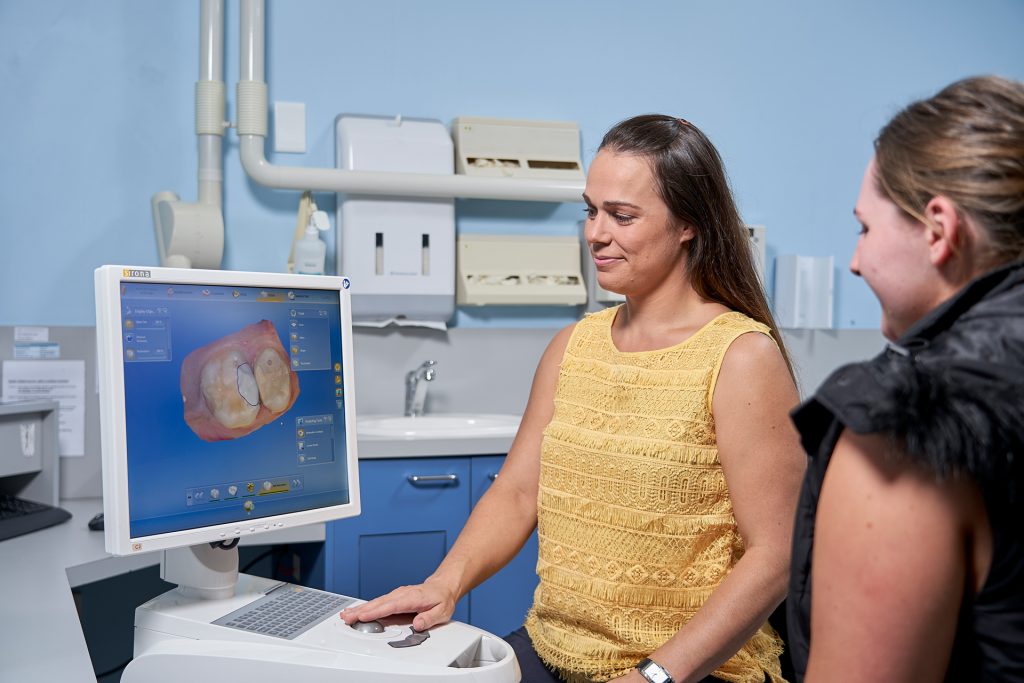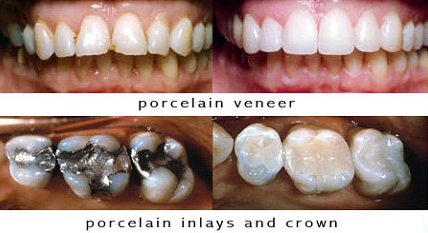CEREC Porcelain Restorations
CEREC — Chairside Economical Restoration of [A]Esthetic Ceramics.
Cerec is a computer-aided system that combines 3D imaging, CAD/CAM [computer aided design/computer aided manufacture] programs and a milling unit to create lifelike dental restorations with incredible speed and precision.
History
Cerec was invented in 1985. In December 1990, Dr Richard Huebl made Riken the first practice in Australia to use the Cerec porcelain restoration technology. And just like mobile phones, technology has dramatically improved since then until today.
Cerec technique
After tooth preparation, the Cerec camera will acquire the tooth image onto the computer screen. After designing the restoration a suitable shaded block is placed into the milling unit. Milling time averages at 8 minutes, after which the restoration is cemented in place.

CEREC restorations are made from ceramic – a natural substance that is particularly compatible with the body.
Top 10 reasons to use Cerec
In no order of importance.
Long term aesthetics
Both resin and porcelain fillings look better than gold or grey amalgam fillings. Tooth coloured resin fillings will look great at first but after a few years will stain. Porcelain will not stain and will keep its toothlike appearance long-term.
Long term function
At Riken, Cerec restorations are bonded with fourth generation bonding, which strengthens and protects the remaining tooth structure. These bonds will last a long time. The first Cerec restoration placed in 1990 is still functioning as good as ever in 2019. This we believe is largely attributed to the use of fourth generation adhesive bonding. In 1990 and still today, we apply aqueous chlorhexidine after etching but before priming to inactivate matrix metalloproteinases [MMPs] which would otherwise breakdown the collagen scaffolding. Stable and strong bonds [ or glue] enable the longterm function of Cerec restorations.
Minimal sound tooth removal
During tooth preparation, with all porcelain and gold preparations, the old filling and active decay are removed. However, with laboratory porcelain preparations, additionally, a sound tooth is removed to allow a path of insertion. With the Cerec system, undercuts can be left [conditions apply]. A major aim with Cerecs is to conserve as much sound tooth structure as possible. Underlying cracks will be an indicator to remove some sound tooth in order to cusp cap fragile cusps. Each tooth preparation is different.
One appointment
Porcelain and gold restorations have always been superior restorations to amalgam and resin fillings. However, they needed to be made in a laboratory and so two appointments were required, with local anaesthetic injections at both appointments and with a temporary filling in place for the 1-2 weeks in between appointments.
No impressions
Required — many surveys have shown that the number one fear for many patients is having an impression tray with setting material placed in their mouth for 4 to 8 minutes for both upper and lower jaws. Claustrophobia, gagging, bad taste and general unpleasantness.
Occlusion
Cerec fillings wear at same rate as enamel. Also, Cerec is used easily to open vertical dimension in mouths which have worn down due to attrition, erosion and tooth decay.
Same wear rate
Same wear rate on opposing teeth as enamel. It is great to have a material that lasts but you do not want a material that wears away opposing tooth structure faster than natural enamel.
Failures are minimal
Many surveys show that Cerec restorations fail less than any other restoration. But just as important is that when failures do occur they are minimal and can be often repaired without replacing the entire restoration. At Riken, we have found a very low decay rate with Cerec restorations due to low plaque retention, strong bonding techniques and regular visits with our hygienists.
Financial for the patient
At Riken, because we are preferred providers with health funds like BUPA and Medibank, the fee charged is contracted at a lower fee. People in all health funds and also patients with no health fund are charged at this lower rate. Riken can afford to do this through efficient practices, with the leading two reasons being Cerecs only need one appointment here in our Adelaide CBD clinic, and we are not charged a laboratory fee.
Research and education
The Cerec technique has continually improved over the past 29 years due to: the Dental company, DENTSPLY SIRONA, committing high research time and development dollars to continually improving Cerec — Riken dentists are committed to continuing education.
Dr Richard Huebl and Dr Meagan Huebl have both been Accredited International Cerec trainers.




